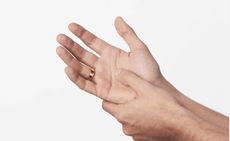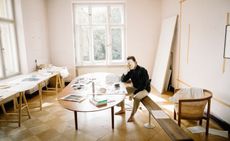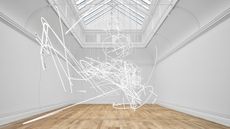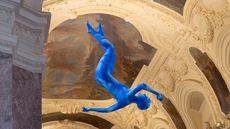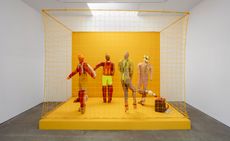Sculptor Leilah Babirye turns found objects into triumphant celebrations of queer identity
Since fleeing Uganda for the US, Leilah Babiyre is now taking the New York art scene by storm. Ahead of her second solo exhibition at Gordon Robichaux, the artist discusses her new, regal sculptures, which transform found objects into visions of a liberated queer and trans community
- (opens in new tab)
- (opens in new tab)
- (opens in new tab)
- Sign up to our newsletter Newsletter

As a Ugandan artist who now lives and works in Brooklyn, Leilah Babiyre might at first glance seem like most other aspiring artists, who move to a cosmopolitan capital in pursuit of furthering their career. In Babiyre’s case, however, her arrival in New York was not under such idyllic circumstances.
Born and raised in Kampala, the capital city of Uganda, Babiyre studied art at Makerere University.
‘I was just an artist working. I had just graduated and was going back to do my master’s, but I wasn’t allowed to go back to do so because I was tackling a lot of LGBTI issues,’ says Babiyre, who was publicly outed as a lesbian by the press in 2015. ‘I got into fights with my father. There were publications of newspapers, so that is when I got a chance to start applying for artist residencies.’

Portrait of artist Leilah Babirye in her Brooklyn studio. Her second solo show at Gordon Robichaux, NY, 'Ebika Bya ba Kuchu mu Buganda (Kuchu Clans of Buganda)' runs from October 11 – November 22, 2020
With her life in Uganda no longer tenable, Babiyre filed applications for artist residencies in Sweden, the United Kingdom, and the United States, where her visa was approved for her to participate in the 2015 Fire Island Artist Residency, an organisation that supports LGBTQ+ visual artists and poets. (Her air ticket was in fact, funded by Kehinde Wiley.) Upon completing the month-long residency, Babiyre stayed on in New York. With support from the African Services Committee, the NYC Anti-Violence Project and the African Human Rights Coalition, who specialise in representing LGBTQI refugees and asylum-seekers, she was ultimately granted asylum three years later in 2018.
‘They told me all I needed was a phone,’ Babiyre recounts. ‘They helped me find a place to settle the first week after Fire Island. They connected me with a professor at Columbia University, who lived in Harlem, and then when I was there, Sam Gordon, the owner of Gordon Robichaux gallery, looked for me. He wanted to show my work and thought I had gone back to Uganda. He asked me if I had made any art, and I had only been drawing and painting. So he gave me his backyard to work and that is how I got back to doing art.’
On 11 October, Babiyre will unveil a new body of work at Gordon Robichaux – her second solo exhibition at the gallery. Entitled ‘Ebika Bya ba Kuchu mu Buganda (Kuchu Clans of Buganda)’, the exhibition presents a series of new wood and ceramic sculptures, which feature found objects, as well as a selection of recent monoprints – all the while drawing from Babiyre’s cultural and ancestral heritage. The city of Kampala is situated in Buganda, one of the most powerful Ugandan kingdoms. Buganda’s clan system, a source of pride amongst its people for its tracing of lineage, also unifies individuals as one interconnected family where members often consider themselves as siblings, in spite of their actual birth relation.

Three glazed ceramics from Babirye’s new series Ebika Bya ba Kuchu mu Buganda (Kuchu Clans of Buganda) in which she reimagines the clans of the Bugandan Kingdom in her native Uganda as queer. On the left, a large blue ceramic, Naggunju from the Kuchu Mushroom Clan, is crowned with braids made from bicycle tire inner tubes. In the centre, Namukalo from the Kuchu Elephant Clan, is a two-part ceramic bound together with a rope Babirye collected from the street
‘I wanted to explore things that are around my culture and things that are very familiar to everybody at home, and even people around the world. People are familiar with their ancestral origins, their cultural leaders,’ shares Babiyre. ‘When I was working on this particular project, I looked at the different clan leaders. I started making pieces and thinking of different clan leaders and the names of the clansmen because people are familiar with them.’
While lineage is traditionally conferred along patrilineal lines, in Babiyre’s case, her sculptural versions of these clanspeople are intentionally fluid. She imagines her own queer ‘kuchu’ community, referring to the ‘secret word’ in the Luganda language, which the queer and trans community use to address each other.
My body of work is involved in representing the queer community; my community, so in a way, [this work] is honouring us as gay people
‘My body of work is involved in representing the queer community; my community, so in a way, [this work] is honouring us as gay people,’ she affirms. ‘I decided to create a community of my own and give my queer sculptures clan names. When people see my work, the discussion will be about why I gave a clan name that is meant to be given to a male, to a sculpture that has hair, that has lipstick, earrings. To me, I feel like I’m presenting my community in a royal way, because we are also humans.’
Babiyre has made around 20 new pieces for the show, ten of which are life-size – a reflection of the amount of working space she now has at her disposal in her Brooklyn studio. ‘I used to work small because of the space in the places that I had been working in, but I recently started working bigger because I have a big studio, I can work outside, I can now explore how much I can produce,’ she says. ‘I was recently signed by Stephen Friedman Gallery in London and though I’ve never been to the space, they told me the gallery has museum [high] ceilings, so I started creating bigger works because I don’t want my work to feel like it doesn’t suit the space. I’m thinking about future exhibitions, in places like museums. If I am given a chance to show my work, I don’t want things to disappear on the floor.’

Babirye gives dignity to her queer and trans subjects and elevates the found materials that punctuate her sculptures: ropes, electrical wires, chains, and locks. Her use of trash in the work is intentional — the pejorative for a gay person in the Luganda language is 'ebisiyaga', which means sugarcane husk. 'It’s rubbish,' explains Babirye, 'the part of the sugarcane you throw out.' The bicycle chains and aluminum cans, which she transforms into ornate textures, hair, and flourishes, refer to her first years in New York as an asylum-seeker collecting cans and working as a bike messenger
Composed of materials ranging from burnished wood to glazed ceramics, Babiyre’s sensual sculptures and masks also poetically incorporate an array of found materials and objects – an intentional gesture that references the pejorative for a gay person in Luganda, ‘ebisiyaga’ which means sugarcane husk. ‘It’s rubbish,’ explains Babirye, ‘The part of the sugarcane you throw out.’
Babiyre’s dignified figures don ornate headdresses crafted from industrial wiring and the tops of aluminium cans. Intricate braids are fashioned from rubber bicycle tire inner tubes, while delicate bead-like adornments on closer inspection are actually bicycle chains.
‘It’s not based on what I like, but based on what I have in the space and what I find,’ Babiyre reveals about her material choices. ‘I randomly pick stuff from the street and then have tons of it in my studio. When I start working and adding found material on a piece, it’s not like I planned it; I find something fitting with something.’

Detail of Nakabazzi from the Kuchu Lion Clan, 2020, wood, metal, nails, screws, and found objects.

Two wood sculptures in progress. Babirye uses a chainsaw and chisels to carve large logs and timbers, which she burns, burnishes, and waxes to create a rich, black surface
‘When I used to make sculptures at home, there is always plenty of wood, plenty of trees to cut down, transportation isn’t hard. But here, there is a limitation. When you’re working on big pieces, you have to decide. At home, it’s easier to call on a community to help you lift a piece, but here you have to put in money. I’m in Brooklyn, who am I going to call to help me? You have all these things in mind as you’re creating. I’m working on very big ceramic pieces and they are costing me a fortune. It is worth it, but transporting them is really hard,’ she says. ‘But because it’s fun making them and seeing the final product, I just keep pushing.’
She adds, ‘The materials that you wouldn’t find at home, because people use it to the fullest – even just plastic bags: somebody who would have a plastic bag from buying bread, the next person would use it for three months as a schoolbag, it’s very hard to find. Here you have plenty. At home, you wouldn’t find a plastic bottle, they’re being used as drinking bottles in schools. Here there is plenty of cloth. In Africa, you’re not going to find any. You won’t find any metal because street kids pick it for their survival.’

Portrait of artist Leilah Babirye in her Brooklyn studio with works in progress
Ultimately, Babiyre defines her work as being intentionally ambiguous. ‘Lots of my works don’t have any definition of gender or sexuality, so you can give them any sexual orientation,’ she says. ‘They don’t hold any [gendered] structures, but they hold character.’
Today, Babiyre reconciles her past and present not only by continuing to represent her LGBTQI culture and Ugandan heritage in her work, but also by giving back. ‘If it weren’t for Kehinde Wiley, I wouldn’t have been able to have my ticket,’ she says. ‘What I’ve been doing is supporting people in the Kakuma refugee camp in Nairobi, Kenya. Every piece that I make, I get a percentage and send it to the LGBTI asylum-seekers there. I also work with people through the African Services Committee, who are applying for asylum and they don’t have their papers. I do Zoom meetings with them and talk about how the week has been, how they feel. Things are very slow ever since Trump became president. It is very hard, especially because there are not enough answers, but you get over it. You have to take everything slowly.’
INFORMATION
Leilah Babirye, ’Ebika Bya ba Kuchu mu Buganda (Kuchu Clans of Buganda)’, 11 October – 22 November 2020, Gordon Robichaux. gordonrobichaux.com
ADDRESS
22 E 17th St
New York, NY 10003
Pei-Ru Keh is the US Editor at Wallpaper*. Born and raised in Singapore, she has been a New Yorker since 2013. Pei-Ru has held various titles at Wallpaper* since she joined in 2007. She currently reports on design, art, architecture, fashion, beauty and lifestyle happenings in the United States, both in print and digitally. Pei-Ru has taken a key role in championing diversity and representation within Wallpaper's content pillars and actively seeks out stories that reflect a wide range of perspectives. She lives in Brooklyn with her husband and two children, and is currently learning how to drive.
-
 Men’s engagement rings for modern grooms
Men’s engagement rings for modern groomsMen’s engagement rings, whether classic or colourful, make for sentimental tokens
By Hannah Silver • Published
-
 Longchamp unites with D’heygere on a playful collection made to ‘transform the everyday’
Longchamp unites with D’heygere on a playful collection made to ‘transform the everyday’Inspired by Longchamp’s foldaway ‘Le Pliage’ bag, this collaboration with Paris-based jewellery and accessories designer Stéphanie D’heygere sees pieces that ‘transform and adapt’ to their wearer
By Jack Moss • Published
-
 Last chance to see: Marc Newson’s all-blue designs in Athens
Last chance to see: Marc Newson’s all-blue designs in AthensGagosian gallery Athens presents new blue furniture and objects by Marc Newson
By Rosa Bertoli • Published
-
 Cyprien Gaillard on chaos, reorder and excavating a Paris in flux
Cyprien Gaillard on chaos, reorder and excavating a Paris in fluxWe interviewed French artist Cyprien Gaillard ahead of his major two-part show, ‘Humpty \ Dumpty’ at Palais de Tokyo and Lafayette Anticipations (until 8 January 2023). Through abandoned clocks, love locks and asbestos, he dissects the human obsession with structural restoration
By Harriet Lloyd-Smith • Published
-
 Cerith Wyn Evans: ‘I love nothing more than neon in direct sunlight. It’s heartbreakingly beautiful’
Cerith Wyn Evans: ‘I love nothing more than neon in direct sunlight. It’s heartbreakingly beautiful’Cerith Wyn Evans reflects on his largest show in the UK to date, at Mostyn, Wales – a multisensory, neon-charged fantasia of mind, body and language
By Harriet Lloyd-Smith • Published
-
 London art exhibitions: a guide for this week
London art exhibitions: a guide for this weekYour guide to the best London art exhibitions, and those around the UK, as chosen by the Wallpaper* arts desk
By Harriet Lloyd Smith • Last updated
-
 Theaster Gates’ New Museum exhibition meditates on mourning, materials and community
Theaster Gates’ New Museum exhibition meditates on mourning, materials and communityTheaster Gates talks about his first US museum show, ‘Young Lords and Their Traces’ at The New Museum
By Pei-Ru Keh • Published
-
 Ugo Rondinone reflects on bodies and nature at Petit Palais
Ugo Rondinone reflects on bodies and nature at Petit PalaisSwiss artist Ugo Rondinone takes over the beaux-arts halls of the Petit Palais with a monumental film installation and sculptures of trapeze dancers
By Jessica Klingelfuss • Last updated
-
 Lucy McRae on gene editing, human intimacy, and tangible science fiction
Lucy McRae on gene editing, human intimacy, and tangible science fictionWe explore the universe of sci-fi artist and ‘body architect’ Lucy McRae, whose science fiction works fuse human intimacy, biological perfection and speculative, yet eerily familiar futures
By Billie Muraben • Last updated
-
 Barbara Chase-Riboud at Serpentine: alternative monuments, parallel histories
Barbara Chase-Riboud at Serpentine: alternative monuments, parallel histories‘Infinite Folds’ at Serpentine North Gallery celebrates Barbara Chase-Riboud, the American artist, novelist and poet who has spent more than seven decades pondering history, memory, and the public monument
By MZ Adnan • Last updated
-
 Los Angeles exhibitions: an ongoing guide to the best shows in town
Los Angeles exhibitions: an ongoing guide to the best shows in townRead our ongoing picks of the best new and upcoming LA art exhibitions to see under the California sun
By Harriet Lloyd-Smith • Last updated
